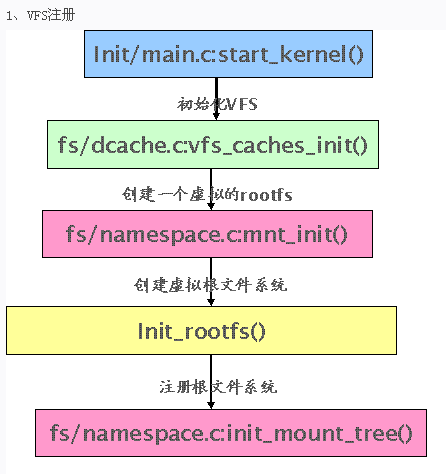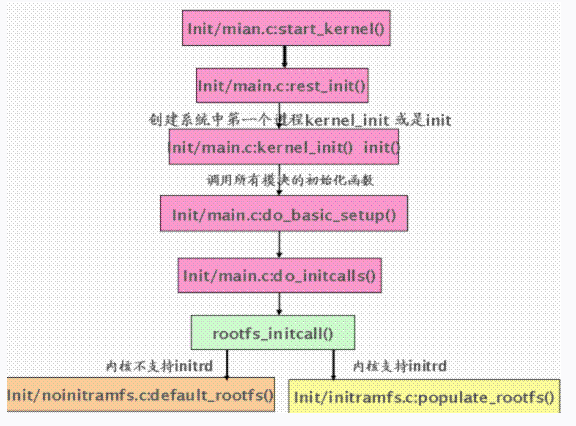前言
在Kernel启动的初始阶段,首先去创建虚拟的根文件系统(rootfs),接下来再去调用do_mount来加载真正的文件系统,并将根文件系统切换到真正的文件系统,也即真实的文件系统。
接下来结核内核代码(内核版本:linux-3.14.28),讲解整个流程。
1、文件系统的分类
文件系统大体可以分为基于内存的文件系统(initrd)和非基于内存的文件系统(noinitrd),想要了解根文件系统的挂载流程,首先要了解各种文件的特性及使用方法。
rootfs: 一个基于内存的文件系统,是linux在初始化时加载的第一个文件系统。
realfs: 用户最终使用的真正的文件系统。
initramfs: 在内核镜像中附加一个cpio包,这个cpio包中包含了一个小型的文件系统,当内核启动时,内核将这个cpio包解开,并且将其中包含的文件系统释放到rootfs中,内核中的一部分初始化代码会放到这个文件系统中,作为用户层进程来执行。这样带来的明显的好处是精简了内核的初始化代码,而且使得内核的初始化过程更容易定制。Linux 2.6.12内核的initramfs还没有什么实质性的东西,一个包含完整功能的initramfs的实现可能还需要一个缓慢的过程。
cpio-initrd: cpio格式的initrd。一般作为最终的根文件系统。
image-initrd: 专指传统的文件镜像格式的initrd,如ext2格式。可以作为最终的根文件系统,也可以作为过渡,由Image-initrd里的init来加载最终的根文件系统。
noinitrd: 如jffs2,yaffs2等格式的根文件系统,作为最终的根文件系统。
2、initrd的处理流程
initrd有CPIO-initrd和Image-initrd两种格式,取决于制作initrd文件系统映像的工具和方法。initramfs是内核自动生成的一个简单的CPIO-initrd。
initramfs的处理流程:
1.如果内核支持initrd,但是并没有配置CONFIG_INITRAMFS_SOURCE选项的话,内核在编译的时候会自动生成一个最小的cpio包附在内核中(这个cpio包的内容与由default_rootfs生成的一样),除非你使用了ramdisk作为文件系统,否则内核按initramfs文件系统启动。
2.将initramfs的内容释放到rootfs中。
3.挂载真实的文件系统。
cpio-initrd 的处理流程:
1.bootloader 把内核以及 initrd 文件系统分别加载到内存的特定位置。然后启动内核,并告诉内核initrd在内存的位置。
2.内核判断initrd的文件格式,如果是cpio格式。
3.将initrd的内容释放到rootfs中。即这时候rootfs就是真正的根文件系统。
4.执行initrd中的/init文件,执行到这一点,内核的工作全部结束,完全交给/init文件处理。
image-initrd的处理流程:
1.bootloader 把内核以及 initrd 文件系统分别加载到内存的特定位置。然后启动内核,并告诉内核initrd在内存的位置
2.内核判断initrd的文件格式,如果不是cpio格式,将其作为image-initrd处理。
3.内核将initrd的内容保存在rootfs下的/initrd.image文件中。
4.内核将/initrd.image的内容读入/dev/ram0设备中,也就是读入了一个内存盘中。
5.接着内核以可读写的方式把/dev/ram0设备挂载为原始的根文件系统。
6.执行initrd上的/linuxrc文件,linuxrc通常是一个脚本文件,负责加载内核访问根文件系统必须的驱动, 以及加载根文件系统。
7.如果/dev/ram0被指定为真正的根文件系统,那么内核跳至最后一步(即第9步)正常启动。
8.否则, 将真实根文件系统(如/dev/mtdblock3或nfs)挂载到rootfs下。
9.在常规根文件系统上进行正常启动过程 ,执行/sbin/init。
二者比较:
1、cpio-initrd的处理流程更加简单,并没有使用额外的ramdisk,而是将其内容直接输入到rootfs中,其实rootfs本身也是一个基于内存的文件系统。这样就省掉了ramdisk的挂载、卸载等步骤。cpio-initrd不再象image-initrd那样作为linux内核启动的一个中间步骤,而是作为内核启动的终点,内核将控制权交给cpio-initrd的/init文件后,内核的任务就结束了,所以在/init文件中,我们可以做更多的工作,而不比担心同内核后续处理的衔接问题。
2、而对于image-initrd,如果最终的真实根文件系统不在Root_RAM0(比如在/dev/mtdblock3或nfs),则内核在执行完image-initrd 里的/linuxrc进程后,还要进行一些收尾工作。并挂载最终执行真正的根文件系统和执行最终真正根文件系统里的init。如果最终的真实根文件系统在Root_RAM0,则挂载最终执行真正的根文件系统和执行最终真正根文件系统里的init。
3、整体流程解读
3.1 根文件系统的注册
首先不得不从老掉牙的Linux系统的函数start_kernel()说起。函数start_kernel()中会去调用vfs_caches_init()来初始化VFS。
void __init vfs_caches_init(unsigned long mempages)
{
…
//创建一个rootfs,这是个虚拟的rootfs,即内存文件系统,后面还会指向真实的文件系统
mnt_init();
}
void __init mnt_init(void)
{
…
//创建虚拟根文件系统(调用register_filesystem(&rootfs_fs_type)注册rootfs,即根文件系统);
init_rootfs();
/*******************************************************************************
*挂载根文件系统(”/”其实这只是个空目录,是后面挂载实际根文件系统的根节点)。
*init_mount_tree会调用 vfs_kern_mount(“rootfs”, 0, “rootfs”, NULL)为 VFS 建立根目
*录“/”,而一旦有了根,那么这棵数就可以发展壮大。同时挂载前面已经注册了的 rootfs 文件系统到
*根目录“/”下。最后调用set_fs_pwd和set_fs_root切换进程的根目录和当前目录为”/”.这也就是根
*目录的由来
********************************************************************************/
init_mount_tree();
} 这个流程如下图所示:
3.2 根文件系统的初始化
3.2.1 noinitrd初始化流程
针对noinitrd的情况,初始化一个简单的rootfs。主要往里面创建两个目录/dev和/root,还有一个结点/dev/console。
/*
* Create a simple rootfs that is similar to the default initramfs
*/
static int __init default_rootfs(void)
{
int err;
err = sys_mkdir((const char __user __force *) "/dev", 0755);
if (err < 0)
goto out;
err = sys_mknod((const char __user __force *) "/dev/console",
S_IFCHR | S_IRUSR | S_IWUSR,
new_encode_dev(MKDEV(5, 1)));
if (err < 0)
goto out;
err = sys_mkdir((const char __user __force *) "/root", 0700);
if (err < 0)
goto out;
return 0;
out:
printk(KERN_WARNING "Failed to create a rootfs\n");
return err;
}
rootfs_initcall(default_rootfs);3.2.2initrd初始化流程
(1)当内核支持initrd时,rootfs_initcall调用initramfs.c中的populate_rootfs()函数。
针对initrd的情况,在kernel启动之前,uboot会把initrd映像(即真实根文件系统)拷贝到外部sram的指定位置。
如果是cpio-initrd,则直接填充到rootfs根目录下,这时rootfs即从vfs变成真实的根文件系统。
如果是Image-initrd,则Image-initrd里面的内容保存到/initrd.image里面。
unpack_to_rootfs顾名思义,就是解压包到rootfs文件系统中。
static int __init populate_rootfs(void)
{
char *err = unpack_to_rootfs(__initramfs_start, __initramfs_size);
if (err)
panic("%s", err); /* Failed to decompress INTERNAL initramfs */
/**********************************
*如果内核支持initrd,但是并没有配置CONFIG_INITRAMFS_SOURCE选项的话,
*initrd_start为0。
***********************************/
if (initrd_start) {
/************************
*支持ramdisk的话,必须定义宏CONFIG_BLK_DEV_RAM
************************/
#ifdef CONFIG_BLK_DEV_RAM
int fd;
printk(KERN_INFO "Trying to unpack rootfs image as initramfs...\n");
err = unpack_to_rootfs((char *)initrd_start,
initrd_end - initrd_start);
if (!err) {
free_initrd();
goto done;
} else {
clean_rootfs();
unpack_to_rootfs(__initramfs_start, __initramfs_size);
}
printk(KERN_INFO "rootfs image is not initramfs (%s)"
"; looks like an initrd\n", err);
fd = sys_open("/initrd.image",
O_WRONLY|O_CREAT, 0700);
if (fd >= 0) {
sys_write(fd, (char *)initrd_start,
initrd_end - initrd_start);
sys_close(fd);
free_initrd();
}
done:
#else
printk(KERN_INFO "Unpacking initramfs...\n");
err = unpack_to_rootfs((char *)initrd_start,
initrd_end - initrd_start);
if (err)
printk(KERN_EMERG "Initramfs unpacking failed: %s\n", err);
free_initrd();
#endif
/*
* Try loading default modules from initramfs. This gives
* us a chance to load before device_initcalls.
*/
load_default_modules();
}
return 0;
}
rootfs_initcall(populate_rootfs); (2)检测根文件系统中是否存在ramdisk_execute_command文件。
这个值由uboot传给内核的参数中rdinit=指定,如果未指定则采用默认的/init。如果ramdisk_execute_command文件不存在则执行prepare_namespace()挂载根文件系统。
如果是cpio-initrd,populate_rootfs已经成功解压cpio-initrd到rootfs中,这种情况下rootfs就是真实的根文件系统,所以这时一般会存在ramdisk_execute_command。
如果是Image-initrd或者noinitrd的情况,一般不会存在ramdisk_execute_command,所以执行prepare_namespace()挂载根文件系统。
start_kernel->rest_init->kernel_init->kernel_init_freeable
static noinline void __init kernel_init_freeable(void)
{
/*
* Wait until kthreadd is all set-up.
*/
wait_for_completion(&kthreadd_done);
/* Now the scheduler is fully set up and can do blocking allocations */
gfp_allowed_mask = __GFP_BITS_MASK;
/*
* init can allocate pages on any node
*/
set_mems_allowed(node_states[N_MEMORY]);
/*
* init can run on any cpu.
*/
set_cpus_allowed_ptr(current, cpu_all_mask);
cad_pid = task_pid(current);
smp_prepare_cpus(setup_max_cpus);
do_pre_smp_initcalls();
lockup_detector_init();
smp_init();
sched_init_smp();
do_basic_setup();
/* Open the /dev/console on the rootfs, this should never fail */
if (sys_open((const char __user *) "/dev/console", O_RDWR, 0) < 0)
pr_err("Warning: unable to open an initial console.\n");
(void) sys_dup(0);
(void) sys_dup(0);
/*
* check if there is an early userspace init. If yes, let it do all
* the work
*/
if (!ramdisk_execute_command)
ramdisk_execute_command = "/init";
if (sys_access((const char __user *) ramdisk_execute_command, 0) != 0) {
ramdisk_execute_command = NULL;
prepare_namespace();
}
/*
* Ok, we have completed the initial bootup, and
* we're essentially up and running. Get rid of the
* initmem segments and start the user-mode stuff..
*/
/* rootfs is available now, try loading default modules */
load_default_modules();
}(3)挂载真实的根文件系统,并把真实的根文件系统的根目录作为进程的根目录。本函数的具体流程,请看注释。
void __init prepare_namespace(void)
{
int is_floppy;
/*************************
*对于将根文件系统存在usb或者scsi的情况,
*kernel需要等待这些耗费时间比较久的驱动
*加载完毕,所以这里存在一个delay。
*************************/
if (root_delay) {
printk(KERN_INFO "Waiting %d sec before mounting root device...\n",
root_delay);
ssleep(root_delay);
}
/*
* wait for the known devices to complete their probing
*
* Note: this is a potential source of long boot delays.
* For example, it is not atypical to wait 5 seconds here
* for the touchpad of a laptop to initialize.
*/
/********************
*等待根文件系统所在的设备的探测函数的完成。
********************/
wait_for_device_probe();
md_run_setup();
/******************************
*saved_root_name是uboot传进来的参数root=/dev/mtdblock3
******************************/
if (saved_root_name[0]) {
root_device_name = saved_root_name;
if (!strncmp(root_device_name, "mtd", 3) ||
!strncmp(root_device_name, "ubi", 3)) {
mount_block_root(root_device_name, root_mountflags);
goto out;
}
/*********************
*ROOT_DEV存放saved_root_name的设备节点号。
*********************/
ROOT_DEV = name_to_dev_t(root_device_name);
if (strncmp(root_device_name, "/dev/", 5) == 0)
root_device_name += 5;
}
/************************************
*挂载Image-initrd,如果bootargs指定了noinitrd,
*那么initrd_load()是空操作。
*************************************/
if (initrd_load())
goto out;
/* wait for any asynchronous scanning to complete */
if ((ROOT_DEV == 0) && root_wait) {
printk(KERN_INFO "Waiting for root device %s...\n",
saved_root_name);
while (driver_probe_done() != 0 ||
(ROOT_DEV = name_to_dev_t(saved_root_name)) == 0)
msleep(100);
async_synchronize_full();
}
is_floppy = MAJOR(ROOT_DEV) == FLOPPY_MAJOR;
if (is_floppy && rd_doload && rd_load_disk(0))
ROOT_DEV = Root_RAM0;
/**********************
*把真实的根文件系统挂在到rootfs的/root目录下。
**********************/
mount_root();
out:
devtmpfs_mount("dev");
/****************************************
*将真实根文件系统从当前目录移动到rootfs的根目录后,
*并进入根目录。
*然后将当前目录设置为系统的根目录,即作为当前进程的根目录。
*所以,最终把虚拟的文件系统切换到了真实的根文件系统。
****************************************/
sys_mount(".", "/", NULL, MS_MOVE, NULL);
sys_chroot(".");
}(4)initrd_load()是针对Image-initrd的函数,注意,前面已经把Image-initrd解压到了/initrd.image里面。
int __init initrd_load(void)
{
/***********************************
*mount_initrd的默认值为1,如果uboot传给kernel
*的参数指明noinitrd,则mount_initrd被置成0。
***********************************/
if (mount_initrd) {
create_dev("/dev/ram", Root_RAM0);
/*
* Load the initrd data into /dev/ram0. Execute it as initrd
* unless /dev/ram0 is supposed to be our actual root device,
* in that case the ram disk is just set up here, and gets
* mounted in the normal path.
*/
/*****************************************
*rd_load_image函数将/initrd.image的内容释放到/dev/ram设备节点。
*如果根文件系统设备号不是Root_RAM0,即给内核指定的参数不是/dev/ram,
*则会调用handle_initrd()。但是一般我们给内核指定的参数是/dev/ram。
******************************************/
if (rd_load_image("/initrd.image") && ROOT_DEV != Root_RAM0) {
sys_unlink("/initrd.image");
handle_initrd();
return 1;
}
}
sys_unlink("/initrd.image");
return 0;
}(5)执行/linuxrc脚本确定真实的根文件系统,接着调用mount_root将真实的根文件系统挂载到rootfs的/root目录下。
static void __init handle_initrd(void)
{
struct subprocess_info *info;
static char *argv[] = { "linuxrc", NULL, };
extern char *envp_init[];
int error;
/**********************************
*real_root_dev为一个全局变量,用来保存真实根文件系统的设备号。
**********************************/
real_root_dev = new_encode_dev(ROOT_DEV);
/**********************************************
*/dev/root.old的设备号是Root_RAM0,而前面已经把Image-initrd释放到了
*Root_RAM0,所以/dev/root.old下的内容就是真实的根文件系统Image-initrd。
**********************************************/
create_dev("/dev/root.old", Root_RAM0);
/* mount initrd on rootfs' /root */
/************************************
*将真实的根文件系统挂载到rootfs的/root目录下。
************************************/
mount_block_root("/dev/root.old", root_mountflags & ~MS_RDONLY);
sys_mkdir("/old", 0700);
sys_chdir("/old");
/* try loading default modules from initrd */
load_default_modules();
/*
* In case that a resume from disk is carried out by linuxrc or one of
* its children, we need to tell the freezer not to wait for us.
*/
current->flags |= PF_FREEZER_SKIP;
info = call_usermodehelper_setup("/linuxrc", argv, envp_init,
GFP_KERNEL, init_linuxrc, NULL, NULL);
if (!info)
return;
call_usermodehelper_exec(info, UMH_WAIT_PROC);
current->flags &= ~PF_FREEZER_SKIP;
/* move initrd to rootfs' /old */
sys_mount("..", ".", NULL, MS_MOVE, NULL);
/* switch root and cwd back to / of rootfs */
sys_chroot("..");
if (new_decode_dev(real_root_dev) == Root_RAM0) {
sys_chdir("/old");
return;
}
sys_chdir("/");
/*************************************
*执行完linuxrc后,真实的根文件系统已经确定,则执行
*mount_root将真实的根文件系统挂载到rootfs的/root目录下。
**************************************/
ROOT_DEV = new_decode_dev(real_root_dev);
mount_root();
printk(KERN_NOTICE "Trying to move old root to /initrd ... ");
error = sys_mount("/old", "/root/initrd", NULL, MS_MOVE, NULL);
if (!error)
printk("okay\n");
else {
int fd = sys_open("/dev/root.old", O_RDWR, 0);
if (error == -ENOENT)
printk("/initrd does not exist. Ignored.\n");
else
printk("failed\n");
printk(KERN_NOTICE "Unmounting old root\n");
sys_umount("/old", MNT_DETACH);
printk(KERN_NOTICE "Trying to free ramdisk memory ... ");
if (fd < 0) {
error = fd;
} else {
error = sys_ioctl(fd, BLKFLSBUF, 0);
sys_close(fd);
}
printk(!error ? "okay\n" : "failed\n");
}
}























 6722
6722

 被折叠的 条评论
为什么被折叠?
被折叠的 条评论
为什么被折叠?








